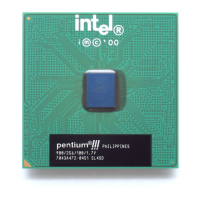Memory Interface Routing
R
Intel
®
Pentium
®
4 Processor / Intel
®
850 Chipset Family Platform Design Guide 99
The amount of capacitance needed depend on the length the signals have to travel though the
RIMM connector pin (i.e., a signal on the bottom layer has to travel though more of the RIMM
connector pin than a signal on the top layer). This can be achieved on the motherboard by adding a
copper tab to the specified RSL pins at each connector.
Table 23. RSL and Clocking Signal Rambus RIMM* Connector Capacitance Requirement
RSL and Clocking Signal Routing Layer Capacitance (pF)
1
Top 0.8
Inner 1 0.9
Inner 2 1.23
Bottom 1.35
NOTE:
1
These numbers are based on a six layer stack-up.
The copper tab area for the recommended stack-up was determined through simulation. The
amount of capacitance required is determined by the layer the RSL or clocking signal is routed on.
The placement of the copper tabs can be on any signal layer, independent of the layer on which the
RSL signal is routed.
Capacitance for a different stack-up assuming a 62mil board thickness can be computed by linear
interpolation. The equation for determining the amount of capacitance needed on any stripline
layer can be found by Equation 6.
Equation 6. Calculation for a Stripline C-tab
Ctab
LayerX
= .8pF + (1.35pF -.8pF)(X/62)
Where
• X is the distance in mils from the top of the board to the stripline signal layer in which the
RSL or clocking signals are routed on.
Equation 7 is an approximation that can be used for calculating copper tab area on the outer layer.
Equation 7. Copper Tab Capacitance Calculation
Length * Width = Area = [C
plate
* Thickness of prepreg] / [ε
0
* ε
r
* 1.1]
Where:
• C
plate
= Capacitance of the plates
• ε
0
= 2.25 x 10
-16
Farads/mil
• ε
r
= Relative dielectric constant of prepreg material
• Thickness of prepreg = Stack-up dependent
• Length, Width = Dimensions in mils of copper plate to be added
• Factor of 1.1 accounts for fringe capacitance.

